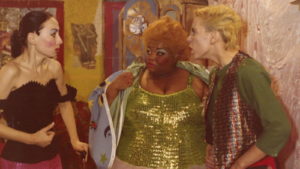
As I did last year, I kicked off my slate at the Fantasia International Film Festival with an action-packed cult amuse-bouche. But this time, rather than marvel at the stupendous amateurishness and flagrant copyright violations of The Man Who Saved the World, my maiden screening this year was a little less memetic and a lot more technically adept: a fully-restored 35mm print of the 1972 Shaw Brothers martial arts extravaganza King Boxer, a.k.a. Five Fingers of Death. Though it hasn’t aged as gracefully as some of its flashier peers, Five Fingers of Death is still a blast from start to finish, and a worthy catalyst for the rise of the kung fu movie in North American theatres in the early ’70s.
Lo Lieh stars as Chao Chih-Hao, a budding martial artist who is sent away to train under the legendary Master Shen (Mien Fang). There he hopes to acquire the skills needed to win a major martial arts tournament, thereby proving himself worthy of the hand of his beloved Ying Ying (Taiwanese Shaw Brothers regular Wang Ping) and preventing the nefarious Master Meng (a weirdly Jean Reno-like Feng Tien) from strengthening his claw-like grip on the region. Then there’s love triangles and peer jealousy and a trio of assassins from Japan who get involved. Also fights break out in bars, dough gets used as a weapon, and a non-zero amount of eyes get gouged out. Suffice it to say that this a movie up to its gills in incident, and not very interested in consolidating any of it for the sake of streamlining the plot. Five Fingers of Death takes the kitchen sink approach, and to its credit, much of it is intriguing, if incredibly well-worn. That’s the downside of being a Rosetta Stone: the elements that make you totemic also end up making you a cliché.
Even moreso than Enter the Dragon, the iconic Bruce Lee film it beat to US shores by six months, Five Fingers of Death is the seminal Hong Kong martial arts film. It fundamentally shaped the popular conception of what a kung fu movie is, from its tropes (the big tournament, school rivalries, the video game-like boss encounter structure, among others) all the way down to the cavalier, often jarring editing. While the fights are fun and fluid, director Jeong Chang-hwa’s propensity for strange inserts and odd framing muddles the action, robbing it of the clarity that someone like Lau Kar-leung would later achieve. Star Lo, who doesn’t have the magnetic charisma of other Shaw Brothers stars of the era, is vastly outmatched in terms of performance by the weird, compelling characters around him on the fringes of the story. There’s more personality in the way Meng Tien-Hsiung (Tung Lam) smokes a cigarette or plays with Baoding balls than in Chih-Hao’s whole character. But Lo is a gifted physical performer, and his work here contributes to Five Fingers of Death‘s joyous verve and unstoppable energy.
This cycle of scrappy early ’70s martial arts films is a monument to some of the simple pleasures in movie-watching. Not just watching the fleet choreography of stunts and ass-beatings, but experiencing blunt, elemental form: sight lines dramatically locking in, giant emphatic zooms, the muscular snare-drum slap when a punch lands. Is it goofy when Chih-Hao’s hands glow crimson as the five-alarm synth wail of Quincy Jones’ theme from Ironside fills the soundtrack, telegraphing a gnarly Iron Palm smackdown? Sure, but it’s also supremely rad. It’s theatre. It’s pro wrestling. It’s Expressionism. It’s everything. And while not an exemplar of the genre, Five Fingers of Death still stands as an important node in the lineage of pop-culture cool, linking Jones to Bruce Lee to the Wu-Tang Clan to Quentin Tarantino. You’re familiar with its students, now pay your respects to the master.
—
Five Fingers of Death a.k.a. King Boxer will screen again at the 2018 Fantasia International Film Festival on July 29th, 2018.
Directed by Jeong Chang-hwa; written by Chiang Yang; starring Lo Lieh, Wang Ping, Wang Ching-Feng, Tien Feng, Tung Lam, Fang Mian, and Ku Wen-Chung; 97 minutes.



 Derek
Derek
 Isabelle
Isabelle